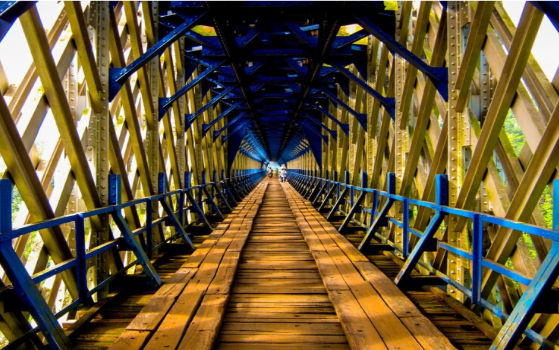Beyond their structural integrity and environmental benefits, timber bridges possess an inherent aesthetic quality that sets them apart in the realm of infrastructure. There’s a timeless charm to wood, a material that connects us to nature and traditional craftsmanship.
A well-designed timber bridge is not merely a functional crossing; it becomes a landmark, a point of visual interest, and a harmonious addition to its surroundings.
This deep-rooted aesthetic appeal is a significant driver behind the increasing preference for timber bridge construction in diverse settings, from serene natural parks to bustling urban landscapes.
1. Natural Harmony and Integration
One of the most powerful aesthetic contributions of timber bridges is their ability to blend seamlessly with natural environments. The organic textures, warm tones, and varied grain patterns of wood resonate with surrounding trees, water bodies, and landscapes.
Unlike the starkness of concrete or the industrial feel of steel, timber structures feel like an extension of the natural world, rather than an intrusion.
This inherent harmony makes timber bridge construction ideal for parks, trails, and rural settings where preserving scenic beauty is paramount.
2. Warmth and Inviting Character
Timber exudes a warmth that no other construction material can truly replicate. The tactile quality of wood, even from a distance, creates an inviting atmosphere.
This warmth translates into a sense of welcome and comfort for those crossing the bridge, transforming a utilitarian structure into a pleasant experience.
This inviting character is particularly valued in pedestrian and recreational areas, where the bridge serves as a focal point for leisure and connection.
3. Timeless Elegance and Rustic Charm
Timber bridges often evoke a sense of timeless elegance and rustic charm. They hark back to an era of traditional craftsmanship, reminding us of simpler, yet robust, construction methods. This classic appeal allows timber bridges to complement both historic and contemporary architectural styles.
Whether it’s a gracefully arched pedestrian bridge or a robust vehicle crossing, the inherent character of wood lends itself to designs that feel enduring and authentic, appealing to a sense of heritage and tradition.
4. Versatility in Design and Form
Despite its natural origins, timber is incredibly versatile, allowing for a wide range of aesthetic expressions in bridge design.
From simple log bridges to complex truss systems and elegant laminated arches, the flexibility of wood enables architects and engineers to create structures that are both functional and visually striking.
Different timber species, finishes, and joinery techniques can further enhance the visual impact, allowing for customization that reflects local character or a specific artistic vision in timber bridge construction.
5. Unique Texture and Grain Patterns
Every piece of timber is unique, bearing distinct grain patterns, knots, and color variations that tell the story of the tree it came from. These natural imperfections are not flaws but rather contribute to the bridge’s individuality and aesthetic richness.
As timber ages, it develops a beautiful patina, deepening its character and adding to its visual interest. This inherent uniqueness ensures that no two timber bridges are exactly alike, offering a personalized touch to each timber bridge construction project.
